|
|
| Sei in: Cinema e Medioevo ® Indice alfabetico dei film |
Giovanna d'Arco
(Joan the Woman)
1916, regia di Cecil B. De Mille
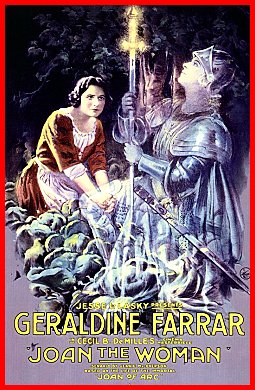

Scheda: Nazione: USA - Produzione: Cardinal Film, Paramount Pictures - Distribuzione: Kino Video, Paramount Pictures - Soggetto: Jeanie Macpherson - Sceneggiatura: William C. De Mille - Fotografia: Alvin Wyckoff - Montaggio: Cecil B. De Mille - Scenografia: Wilfred Buckland - Costumi: Miss Hoffman - Musiche: William Furst - Formato: B.N. (alcune sequenze a colori con il metodo «De Mille-Wyckoff»), muto - Durata: 100' (138').
Cast: Geraldine Farrar, Raymond Hatton, Hobart Bosworth, Theodore Roberts, Wallace Reid, Charles Clary, James Neill, Tully Marshall, Lawrence Peyton, Horace B. Carpenter, Cleo Ridgely, Lillian Leighton, Marjorie Daw, Stephen Gray, Ernest Joy, John Oaker, Hugo B. Koch, William Conklin, Walter Long, William Elmer, Emilius Jorgensen, Ramon Novarro.


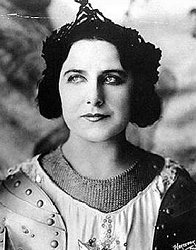

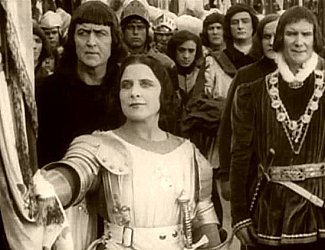
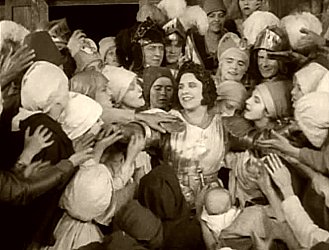



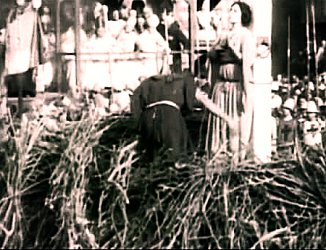

![]() Trama e commenti:
it.wikipedia.org -
movieplayer.it -
kataweb.it:
«Durante la guerra 1914-18 sul fronte francese un giovane soldato britannico
(Reid) sogna la Pulzella (Farrar) che lo incita a morire per la Francia al fine
di riscattare i peccati degli inglesi nei suoi confronti: dopo aver liberato
Orléans era stata tradita da un soldato inglese, di lei invaghito e da lei
respinto, e bruciata sul rogo. Il soldato esegue, morendo in un'incursione
notturna contro i tedeschi. Scritto da Jeanie MacPherson, è uno dei 9 film che
De Mille diresse nel biennio 1916-17, e il suo 1 colosso storico, il 1 in cui
per certe sequenze ricorse al colore con un procedimento meccanico di
impressione, messo a punto con gli ingegneri della Paramount, al quale fu dato
il nome di "procedimento De Mille-Wyckoff". Almeno nelle intenzioni, il titolo
implica che il regista voleva raccontare la vita di una giovane contadina con le
sue debolezze, tentazioni, impulsi. E, comunque, una grossa macchina
spettacolare di propaganda bellica e interventista. A favore degli Alleati,
s'intende: "... ricco di scene di guerra e di sequenze oniriche, insegnava il
patriottismo facendo appello alle più ricche sorgenti emotive: l'amore e la
religione" (Lewis Jacobs). Celebre soprano di eccezionale bellezza, la Farrar
(1882-1967) interpretò una quindicina di film tra il 1915 e il 1919».
Trama e commenti:
it.wikipedia.org -
movieplayer.it -
kataweb.it:
«Durante la guerra 1914-18 sul fronte francese un giovane soldato britannico
(Reid) sogna la Pulzella (Farrar) che lo incita a morire per la Francia al fine
di riscattare i peccati degli inglesi nei suoi confronti: dopo aver liberato
Orléans era stata tradita da un soldato inglese, di lei invaghito e da lei
respinto, e bruciata sul rogo. Il soldato esegue, morendo in un'incursione
notturna contro i tedeschi. Scritto da Jeanie MacPherson, è uno dei 9 film che
De Mille diresse nel biennio 1916-17, e il suo 1 colosso storico, il 1 in cui
per certe sequenze ricorse al colore con un procedimento meccanico di
impressione, messo a punto con gli ingegneri della Paramount, al quale fu dato
il nome di "procedimento De Mille-Wyckoff". Almeno nelle intenzioni, il titolo
implica che il regista voleva raccontare la vita di una giovane contadina con le
sue debolezze, tentazioni, impulsi. E, comunque, una grossa macchina
spettacolare di propaganda bellica e interventista. A favore degli Alleati,
s'intende: "... ricco di scene di guerra e di sequenze oniriche, insegnava il
patriottismo facendo appello alle più ricche sorgenti emotive: l'amore e la
religione" (Lewis Jacobs). Celebre soprano di eccezionale bellezza, la Farrar
(1882-1967) interpretò una quindicina di film tra il 1915 e il 1919».
![]() Plot Summary, Synopsis, Review: IMDb
-
allmovie.com -
en.wikipedia.org -
publishing.cdlib.org
-
moviessilently.com
-
silentera.com
-
entertainment.msn.com -
digitalsilents.com:
«Without a doubt Cecil B. DeMille’s Joan The Woman is a masterpiece.
The first of DeMille’s historical epics, Joan The Woman contains many of
what would soon become DeMille signatures: the huge cast of extras in
extraordinary scenes; the not-so-subtle symbolism; scenes of debauchery; and, of
course, sex. Yes, even in the story of Joan of Arc DeMille is able to include
sex, albeit more “tastefully” than in some of his later productions. There’s an
odd and rather contrived framing story in Joan The Woman, which begins
the epic tale in the French trenches during World War I. English soldier Reid
unearths an old sword and muses over its previous owner while also coming to
grips with an impending mission, which would cost him his life. The story then
slips into the past and becomes the story of the Maid of Orleans, Joan of Arc.
The English forces are invading France and Joan, after hearing voices, persuades
the French aristocracy that she should lead the French soldiers in battle
against the enemy. She is indeed successful, but there are conspirators, who set
out to undermine the maid, and they too are successful and Joan of Arc is burned
at the stake. The framing story returns with Reid accepting the mission and his
sacrifice of himself for the mission’s success. Sure Joan is Hollywoodized
somewhat in the production. In fact, it could appear that her main motivation
may be her contradictory feelings for British soldier Eric Trent (also Wallace
Reid), whose life Joan saves more than once. This interesting ‘twist’ in the
Joan of Arc story allows DeMille to provide even more religious references (as
Trent could easily be compared with Judas) as well as adding a bit of sexual
tension in the narrative. Geraldine Farrar’s portrayal of Joan is at times a bit
over-the-top, but that’s to be expected, as Farrar was a one-time grand opera
diva herself, and her broad performance actually fits quite well for the Joan
character, after all, it is she who is hearing voices. The real star of Joan
The Woman, however, is Cecil B. DeMille himself. His direction was never
better, particularly in the grand battle scenes ...».
Plot Summary, Synopsis, Review: IMDb
-
allmovie.com -
en.wikipedia.org -
publishing.cdlib.org
-
moviessilently.com
-
silentera.com
-
entertainment.msn.com -
digitalsilents.com:
«Without a doubt Cecil B. DeMille’s Joan The Woman is a masterpiece.
The first of DeMille’s historical epics, Joan The Woman contains many of
what would soon become DeMille signatures: the huge cast of extras in
extraordinary scenes; the not-so-subtle symbolism; scenes of debauchery; and, of
course, sex. Yes, even in the story of Joan of Arc DeMille is able to include
sex, albeit more “tastefully” than in some of his later productions. There’s an
odd and rather contrived framing story in Joan The Woman, which begins
the epic tale in the French trenches during World War I. English soldier Reid
unearths an old sword and muses over its previous owner while also coming to
grips with an impending mission, which would cost him his life. The story then
slips into the past and becomes the story of the Maid of Orleans, Joan of Arc.
The English forces are invading France and Joan, after hearing voices, persuades
the French aristocracy that she should lead the French soldiers in battle
against the enemy. She is indeed successful, but there are conspirators, who set
out to undermine the maid, and they too are successful and Joan of Arc is burned
at the stake. The framing story returns with Reid accepting the mission and his
sacrifice of himself for the mission’s success. Sure Joan is Hollywoodized
somewhat in the production. In fact, it could appear that her main motivation
may be her contradictory feelings for British soldier Eric Trent (also Wallace
Reid), whose life Joan saves more than once. This interesting ‘twist’ in the
Joan of Arc story allows DeMille to provide even more religious references (as
Trent could easily be compared with Judas) as well as adding a bit of sexual
tension in the narrative. Geraldine Farrar’s portrayal of Joan is at times a bit
over-the-top, but that’s to be expected, as Farrar was a one-time grand opera
diva herself, and her broad performance actually fits quite well for the Joan
character, after all, it is she who is hearing voices. The real star of Joan
The Woman, however, is Cecil B. DeMille himself. His direction was never
better, particularly in the grand battle scenes ...».
![]() Approfondimenti:
Movie
Review
Approfondimenti:
Movie
Review